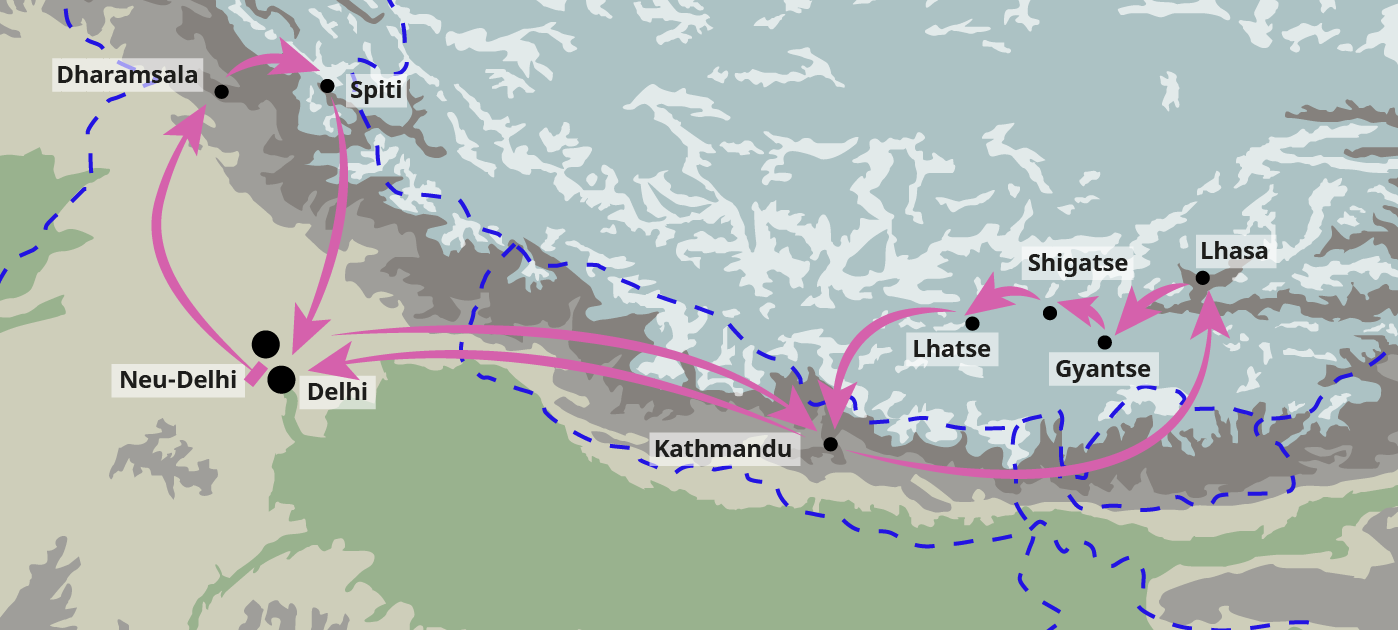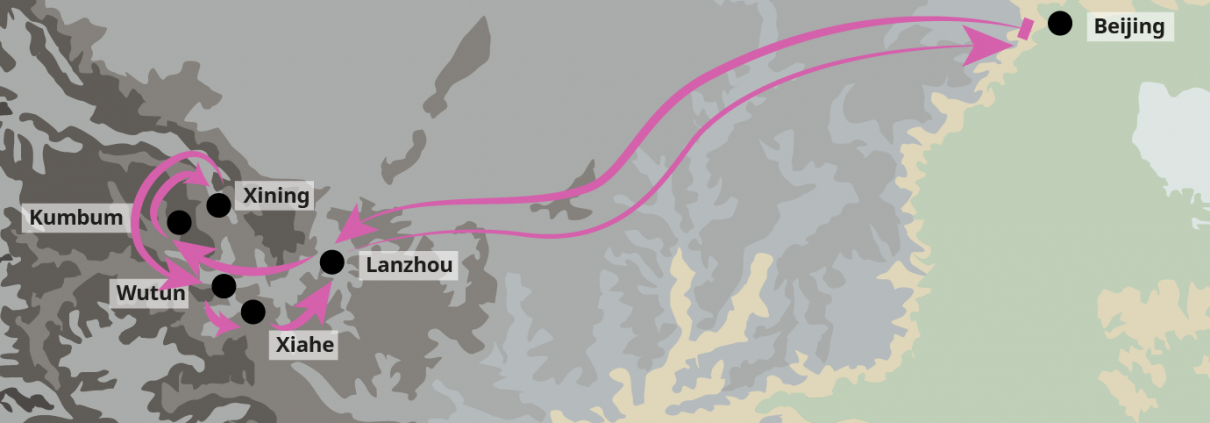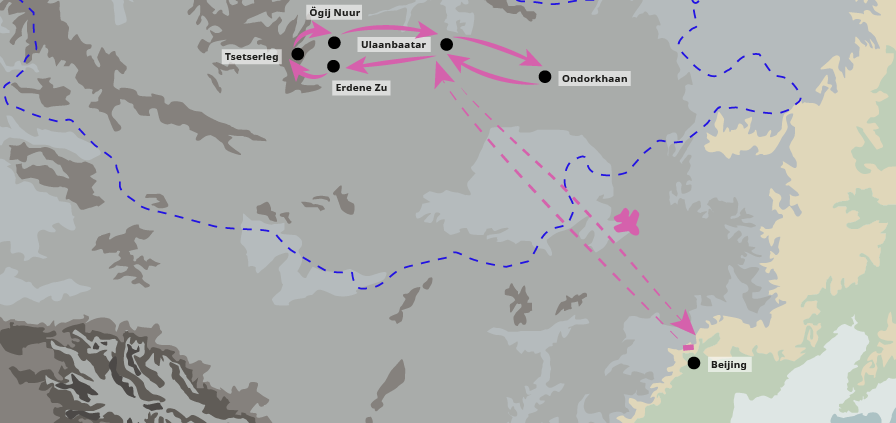Kahlen Collection
Wolf Kahlen handed over his collection on East and Central Asia as well as on the Tibetan scholar Thang-stong-rgyal-po to the East Asia Department of the Staatsbibliothek zu Berlin in the summer of 2023. The photos, travel diaries and documentary films are available in digital form. To view the travel diaries and documentary films, please contact x-asia@sbb.spk-berlin.de.
The Collector
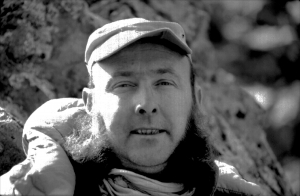
Wolf Kahlen, 1986 in Lhasa, photographed by Jürgen Grimm
Wolf Kahlen (born 1940) is a German pioneer in the field of video art, performance artist and Tibet researcher. He studied art, art history and philosophy at the Werkkunstschule (School of Applied Arts) Braunschweig, the Ateneum Helsinki, the Hochschule der Künste Berlin, the Freie Universität Berlin and Columbia University in New York. Since 1969, his art work has focused on film and video, video sculpture, photography and performance. In addition, by co-initiating the video forum “Neuer Berliner Kunstverein (NBK)” (1970/71) and founding the art center “Ruine der Künste” (1982), he has created spaces and opportunities for his and others’ art. He has held various teaching positions at German and international universities, including Rutgers University (New Jersey, 1977) and the Massachusetts Institute for Technology (1980/81), and from 1982 until his retirement he was Professor of Intermediate Art at the Faculty of Architecture at the Technische Universität Berlin.
Since 1985, he has continuously filmed video documentaries on Tibetan Buddhist culture in Tibet and the Himalayan region (especially Bhutan, Nepal, Sikkim and Spiti), India, Mongolia and China. In doing so, he repeatedly followed in the footsteps of Thang-stong-rgyal-po, a Buddhist scholar and master builder of the 14th century.
Kahlen is married to Barbara Kahlen, a German ceramic artist. Together they have a son, Timo Kahlen, who is active as a media and sound artist.
Thang-stong-rgyal-po
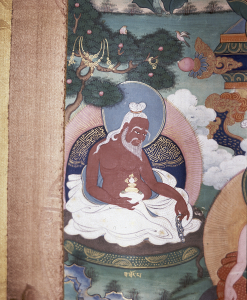
Thang-stong-rgyal-po, detail of a thangka, photographed during the Thang-stong-rgyal-po expedition in 1988
Thang-stong-rgyal-po was a Buddhist scholar of the 14th century. Born in Vo-ba lHa-rtse in gTsang in 1361, he was ordained as a child and spent much of his youth meditating and learning Buddhist practices. He showed an early interest in the rNying-ma school and is regarded as the re-discoverer of some gTer-ma, so-called treasure texts. These are texts that were usually hidden by the Buddhist scholar Padmasambhava and rediscovered from the 11th century onwards. His life was characterized by an immense amount of travel from Swayambhu in Nepal to Wutaishan in China, through the whole of Tibet. His monastic centers were in Ri-bo-che in La-stod and in Cho-bo-ri near Lhasa. According to tradition, he died in 1485, at the age of 124.
Tibetan sources emphasize his five greatest merits. He built iron chain bridges at a total of 58 locations throughout Tibet, met a Chinese emperor, probably Chu Ch’i-chen (r. 1436-1449) and taught him the basics of Buddhist rule, converted King Kāmata, who had previously practised human sacrifice, to Buddhism, civilized the Klo, a tribe in southwestern Tibet, and built stupas and other religious buildings at various key points in the Tibetan topography. In addition, he is considered the founder of the Tibetan theater tradition Ache Lhamo (Xa-ce lha-mo), in which classical themes such as Buddhist stories, life stories of important personalities and historical events are performed in plays with dance and music elements. He was also responsible for the construction of the first temple of the great monastery in sDe-dge and discovered the iron deposits in Tsa-gong, Pa-gro and sKyid-grong. In addition to the construction of bridges and religious buildings, he is also credited with the construction of ferries.
Travels
Between 1985 and 1994, Wolf Kahlen undertook a total of five trips through China, Tibet, Mongolia, Myanmar and Thailand. The Kahlen Collection consists of diary entries made during these trips as well as photographs, video recordings or documentary films. The journeys are briefly presented in chronological order below.
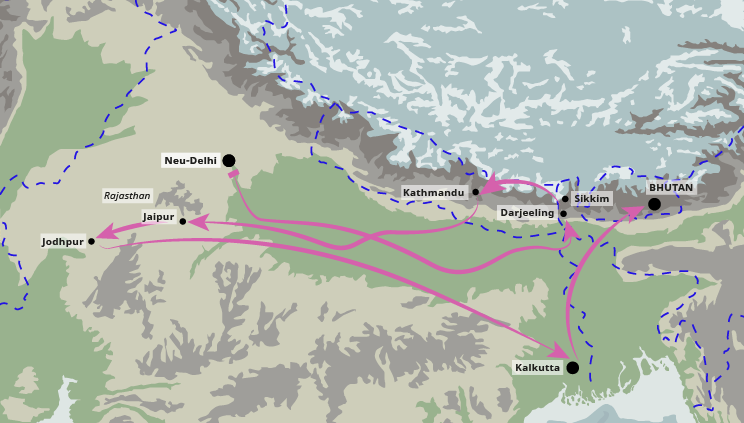
Route of the 1st trip starting in New Delhi to Bhutan
The first trip relevant to the collection took place between February and mid-May 1985. Wolf Kahlen’s wife also took part in it. The route stretched from New Delhi, where they had travelled by plane from Germany, via Darjeeling to Sikkim, where they spent a few days visiting Gangtok and Rumtek Monastery in particular. In the latter, the two spent the Tibetan New Year festival Lo-gsar. They then travelled to Kathmandu (Nepal) and made several excursions into the surrounding area, for example to Chobhar, Pharping and Bodnath. From Bhaktapur they returned to Kathmandu and from there back to India with a detour to Rajasthan (especially Jaipur and Jodhpur) before continuing via Calcutta to their actual destination of Bhutan on April 15th 1985. There are no written diary entries of the stay in Bhutan itself, but there are many sketches. Most of the materials from their time in Bhutan are now in the Royal Library in Thimphu, as Kahlen was a Consultant for Art and Architecture to the Royal Government of Bhutan. As a result, it is no longer possible to reconstruct the final travel route in Bhutan with the available materials. The entries in the accompanying diary were written by both Barbara and Wolf Kahlen.
Collection
Wolf Kahlen’s collection comprises three groups of objects: photographs, travel diaries and documentary films. They are stored digitally at the Staatsbibliothek zu Berlin. This is a collection of 4957 photos documenting Wolf Kahlen’s travels. Most of them taken by himself. During the Thang-stong-rgyal-po expedition in 1988, however, photographs were also taken by Waldemar Czechowski and Marek Kalmus, which were handed over to Kahlen and his project. The entire photo collection is accessible online. The travel diaries reflect the processes and experiences, but also the subjective assessments of Wolf Kahlen during the trips described above. They were typed up by hand by Wolf Kahlen himself in 2012 and are now available as PDF files. The original texts have not been changed; insertions and additions are highlighted in italics. In addition, individual pages, especially those with drawings such as floor plans and landscapes, have been scanned and inserted at the corresponding positions. The diary of the first trip in 1985, titled “Asien”, originally consists of two volumes, which are available electronically in one file. It is 65 pages long. In addition to Wolf Kahlen, a significant number of entries were made by his wife Barbara Kahlen. Her entries are set off from those of Wolf Kahlen in italics. The individual entries are sorted and dated chronologically. From page 54, the diary consists only of drawings, for example of temples, everyday scenes and landscapes as well as rubbings, as they had decided upon entering Bhutan that they would no longer keep a diary and would only draw: „ And now BHUTAN: We no longer write a diary, only draw and are overwhelmed every minute, full of peace and happiness.” (Kahlen, Wolf and Kahlen, Barbara (1985, digitized in 2012): Diary Asia 1985, p. 54). The original diary for Kahlen’s second trip in 1986 is also in two volumes, the file is 78 pages long. Before the actual diary text begins, Kahlen points out that he has reworded some passages to make them easier to understand and that specific travel tips, prices and dates that he had noted down for later trips have been omitted. The entries are dated and in chronological order. In some places, he has included scans of his drawings from the diary or photos that he took on site. The third trip in 1988, also known as the Thang-stong-rgyal-po expedition, was recorded by Kahlen in two diaries and has now been summarized in a PDF file with a total of 96 pages. The diary entries are dated and sorted chronologically. In some places, as with the other diaries, there are scans of the original pages, usually with drawings. In contrast to the other diaries, Kahlen also makes repeated use of drawings by Waldemar Czechowski. Subsequent additions have been added in italics, partly more detailed descriptions inserted from memory for better understanding, partly people were added later in order to protect them, for example if the diary had been confiscated. The diary of Kahlen’s fourth trip to Beijing and Tibet in 1990 is originally a loose-leaf collection. The file comprises 37 pages. The beginning of the travel diary no longer exists. Subsequently added passages can be distinguished from the original text in italics. These are primarily more detailed descriptions and passages critical about China. The documentation of Wolf Kahlen’s last journey in 1994 from Beijing to Mongolia and back consists of two files. One contains, as with the other travel diaries, travel descriptions by Wolf Kahlen on a total of 134 pages. The second file contains scans of the drawings from the travel diary and of Kahlen’s correspondence with his family in Germany, but also with the German Embassy and Mr. Zagalog on 99 pages. The correspondence is available in various languages: German, English, Russian and Mongolian. This structure differs greatly from that of the other four diaries. For contractual reasons and to protect personal rights, the travel diaries are only available on request. Please contact x-asia@sbb.spk-berlin.de. The Kahlen Collection also includes a total of 28 documentary films made during the journeys described. The travel diaries show that the ideas for some of the films already existed before the start of the journey (e.g. in the case of the documentary film about Thang-stong-rgyal-po), while others were developed spontaneously during the journey (e.g. in the case of the documentary film about the enthronement of Serkong Rinpoche). The films were made in the 1990s. For contractual reasons, the documentaries are only available on request. Please contact x-asia@sbb.spk-berlin.de.Photos
Travel diaries
Documentary films
Answered Before Questioned II (Akong Rinpoche)
Duration: 00:08:29 h
Year: 1986
Country: Germany
Akong Rinpoche, a Tibetan Dharma teacher of the Kagyüpa lineage, as a guest at the Ruine der Künste Berlin. Asked to speak about awareness (active perception and consciousness), we see here a collection of his minutes of silence, which leave room to be aware ourselves.
Der Dämon im Stein
Duration: 01:54:05 h
Year: 1988
Country: India/Germany
The 14/15th century Tibetan mahasiddha Thang-stong rGyal-po (spoken: tungtonggyulpo) coined by Wolf Kahlen as a Leonardo of Tibet, because of his many genious activities, is the founder of Tibetan theater A-lche lha-mo. His plays are known well, but a missing link for a proof of this assumption had not yet been searched for. Kahlen found it in 1988 in Spiti: this until then undocumented ceremony, thought to have vanished by long, called Pho-bar rdo-gcog (Breaking of the Stone), incorporates within a pre-buddhist (Bon) ritual a history lesson. The astounding dramaturgy of the event obviously is a masterpiece. There might have been changes in the run of more than 500 years. But the ritual repeatedly was attributed to the Great Magican, and is still practiced today in the high plain deserts of Spiti, a country secluded by mountain passes and cut off from the rest of the world by politics, since it is neighbouring Tibetan Guge, Tsaparang and Tholing, in the most eastern corner of Himachal Pradesh, India, at the ‚Chinese‘ border. The content of the ritual are several differently accentuated tries first to ask friendly, then ban, then chase or force a demon, who has hidden inside a rock of a temple doorstep, to leave the place, since he is the originator of an epidemic disease in Lhasa. Blessings, offerings, sword dances and the use of the magic dagger (phur-bu) are all in vain. Finally, to set the demon free, the rock is placed on the chest of an initiated one in trance, and smashed by a river boulder. The historical part within the two hours ritual is structured like a funny event in the beginning, when a nomad pretends to be a buddhist believer, later discovered as an enemy of „religion“ in general, as the „Wild King of the North“ himself, who has to be killed finally. This input calms down the dense tension of the ritual, then leads up step by step to the final solution of the ritual. The film is one of the results of the Wolf Kahlen lead First International Thang-stong rGyal-po Expedition 1988, and shows the search and finding of the fully recorded, here abbreviated ceremony. It is both a sensational scholarly research, and, since seen by an artist, an emotional loaded experience.
Tibets Leonardo - Der Architekt und Eisenkettenbrückenbauer
Duration: 00:52:49 h
Year: 1985-1995
Country: Tibet/India/Germany
The Crazy Mahasiddha (magic enlightened one) Thang-stong rGyal-po (spoken tung-tong gyal-po) 1364-1485, was one of the most illustrious personalities of Tibet in the middle ages. During his extremely long life, in a time of renaissance of Buddhism, he‚ the king of the empty plains‘ started a number of outragious innovations, of which some changed Tibet dramatically until today, others vanished. The methods he used were the one of a ‚smyon-pa‘, a crazy holy one. If we, at the Thang-stong rGyal-po Archive Berlin, had had not translated his biography in detail and made research over the years since 1985 to prove it, his vital and energetic deeds would otherwise be undiscovered and unbelievable. He not only invented and built iron-chain-bridges, which do not corrode until today, started the Tibetan opera, developed medicines, still used today, influenced the iconography of paintings, sculpted statues, composed work songs, invented a revolutionary type of architecture, today vanished, but also wrote poetry, taught to bridge the gaps between philosophical schools of his time, and went into retreats to meditate several times for years on his life long nomadic journey between Pakistan and Assam of today. This second film (the first called ‚The Demon in the rock‘ documents the ‚Breaking of the Rock‘ ritual that originated the Tibetan theater) as an example of his work, shows among other discoveries his spectacular iron-chain bridge, discovered by us in 1988, and a choerten architecture at Riwoche, and tells the story of their erection in the original words of his so far unpublished biography. (Six further films on his other ‚occupations‘ shall follow)
Vom Leben und Sterben und der Wiederkehr des Serkong Rinpoche. Und seine Inthronisation im Kloster Tabo in Spiti
Duration: 01:59:35 h
Year: 1988
Country: Germany/India/Tibet
On 27 August 1983, one of the most influential teachers of Tibetan Buddhism in general, its iconography, oracles, the Kalachakra ritual and philosophical disputation in particular, the master debater and lifelong close confidant of His Holiness the XIV Dalai Dalai, Tsenshap Serkong Rinpoche, died in the 4200-metre-high village of Khibber in the land of Spiti on the Tibetan border, a few days’ journey from Guge, Tsaparang or Tholing, had it not been for the Chinese border. He died as a tantric in the practice of donglen, taking on the suffering, danger or death of another. In May 1988, his rebirth was discovered in Lhari in Spiti and he was ordained as a monk and enthroned as a tulku in September at the age of 5. The film tells of the life of the ‘old’ Serkong, his death and what the inhabitants of the country experienced as miracles and familiarises us with the ‘normal louse boy’ before the celebrations in his parents’ house, accompanies him through the night when his hair is cut and he is dressed in robes and taken to the thousand-year-old monastery Tabo at dawn. Hundreds of people from all parts of the country and the neighbouring countries of Sikkim, Ladakh, Mustang and Dolpo await him there. He is ceremoniously enthroned over three days and, patiently blessing him, is worshipped until three oracles go into a trance at the end of the days to tell him the future. This unique, authentic documentary footage of the simple yet dignified events from the wasteland of the high deserts of Spiti is not only of great historical and Buddhist philosophical value, but also touching and moving, as it is seen through the eyes of the artist. The film could only be realised with the active help and full sympathy of the Tabo monastery, its monks and its abbot Sonam Wangdu, the initiative of the long-time servant Serkong Rinpoche, Ngawang, and through the meticulous descriptions of life by his close student and translator, Dr Alexander Berzin, and the self-sacrificing expedition team Padma Wangyal, Marek Kalmus and Waldemar Czechowski. In addition to the German version, there is also a Tibetan version, with which we want to give back to the Tibetans what belongs to them. The film is free of Western fictions, utopias or daydreams and of all political power games, which, as history has shown, do not stop at reincarnations.
Unterm Himmel - Auf der Erde - (Pflügen in Spiti)
Duration: 00:21:01 h
Year: 1988
Country: India/Germany
May 1988, below Kye Monastery, 3000 metres and more up in Tibetan Spiti.
The valley resounds again with rhythmic singing and orders to the dzos to work.
A family ploughs the still winter-hard earth. Biblical images: Close under the sky, firmly stuck to the earth.
The men guiding the wooden plough sing a work chant, as is customary in Tibet.
Some of these chants originate from “Tibet’s Leonardo” Thang-stong rGyal-po;
we don’t know that about this one, or is it rather only in its repetition,
like the beads of the prayer chain, a purely mantric-suggestive rhyme?!
The clod of earth cannot simply be broken;
with the hoe and by smashing the lumps from above with their bare hands they have to help.
The wide high plateau between the mountain ranges on both sides
lies bare in the harsh sunlight and cold gusts of wind.
Rock, stone and dust: earth in all states of matter.
Above it all, the monastery crowns a single rocky outcrop, with those who are attached below and those who are not supposed to be attached above.
Close together.
Dreimal Chi - Die Urkraft Chinas
Duration: 00:50:36 h
Year: 1990
Country: China
Three ways of directing the inner spiritual and actual forces that the Chinese call Chi, which flow through the body and soul like “wind” (Chi): The well-known form of Tai Chi (shadow boxing), practised here at dawn by laymen and masters on the most beautiful spot in China, the banks of the West Lake in Hangzhou, the old imperial city. The second way of conducting Chi is a sensational way, shown here for the first time, of taking Chi powers from sacred trees, falling into a trance and shouting, crying or shaking one’s problems and illnesses out of the body. This is a rigidly forbidden form of an ancient practice that is dangerous in a socialist state because people could express themselves uninhibitedly in this trance. Janov-like. At an unnamed location in Beijing in the freezing winter. The third Chi Gong practitioner is an extraordinary traditional Chinese who is actually able to control the Chi forces around his body, to make them act like buffers or to use them as weapons. Attackers fly metres away from him before they can touch him. You can see this very clearly in close-ups. All three types are filmed without commentary, with the consent of the practitioners.
Wolken die Berge versetzen
Duration: 00:36:32 h
Year: 1990
Country: China/Germany
China’s secret soul connection to nature are The Yellow Mountains (Huangshan). Emperors, hermits, artists and philosophers went into retreat here. Numberless works of art, paintings, poetry, pieces of music, or philosophical treatises were created here. In memory of the impressions of these imagination startling ranges. Most parts of the year hidden in clouds. Ageless pine trees shaped by storms and weather survive as models for bonzais. What generations of Chinese artists painted, here you find it. Their styles seem having been pure naturalism ever. The only permament phenomenen of our world, the changes of and in all, here you see it as a never ending dance and play of the forces of nature. Days in clouds and rain and wind. Huangshan is in every Chinese’ heart. It is a part of the national character, a raw material of Chinese Ethnology. But then the tourists came…
Mit meinen Gelben Augen
Duration: 00:08:02 h
Year: 1999
Country: Tibet/Germany
Mit meinen Gelben Augen is the only piece in which Wolf Kahlen talks about his relationship to China’s policy towards Tibet. The preliminary text can be read in the pictures here and describes the situation.
As the monks streaming out of the large meditation hall in the Kumbum monastery in north-east Tibet after morning prayers in the icy cold pass through the entrance portal towards him, he slowly fades in on how he is turning yellow and feeling his vision clouded, with yellow eyes and yellow skin, then experiencing hepatitis and later the temporary “yellow Chinese gaze” clears again. The clouding and clearing of the golden yellow Tibetan colour as a metaphor for a mental process. An exceptional piece, and only because it was written in this very monastery “taersi” (chin. ), which, like a few others, is still under the care of the Panchen Lama, who died “suddenly”, as it is officially called, at the end of January 1989 in Shigatse in the Tashilunpo monastery after his long-awaited return and after criticising China’s Tibet policy for the first time shortly beforehand, and the filmmaker himself had some unpleasant experiences in both monasteries, which are firmly in Chinese hands, there are smuggled-in fake monks there.
Der Lama, die Jurte, das Orakel Unterwegs mit einem Lama in der Mongolei
Duration: 01:48:00 h
Year: 1994 (1995)
Country: Mongolia/Germany
In 1994, Wolf Kahlen spent two months travelling with the Mongolian lama Zagdag in the yurts, on horse or yak back in the steppe. Or in the lama’s yurt a stone’s throw from the Ganden monastery in Ulan Bataar or in Karakorum, Genghis Khan’s residence, now called Erdene Zuu. The artist is actually following in the footsteps of a Tibetan Mahasiddha named Thang-stong rGyal-po, the Leonardo of Tibet, as he records the day and night of a lama here. His commitments to the visiting nomads, giving blessings, hope or oracles. In particularly slow and long camera movements, you actually get a different sense of time and a circular, not a linear one according to Buddhist philosophy. Thanks to the Lama, Lama Sanjdorj, Ganden Tegchoeling Monastery, the abbots and monks of Erdene Zuu, Bereven, Zumod and others, Jhado Rinpoche and Thubten Tashi, Bakula Rinpoche and Soneam Wangchuck, Majciech Goralski and many others.
Dakinis in Jurten - Chöd-Meisterinnen der Mongolei
Duration: 01:37:59 h
Year: 1994
Country: Germany/Mongolia
The Buddhist Vajrayana practice of the Chöd ritual was practised particularly intensively by women in Mongolia before the destruction or self-abandonment of Lamaism in the 1930s, who – even without ordination, which was not possible – led a life as nuns. Only a few – all of whom are now well over 80 years old – have survived and, banned for 60 years, practised in secret – now revered again. The practice of Chöd took place in the steppe, in their own yurt, in the wastelands of the mountains or in cemeteries. The aim of the ritual is to offer one’s own body to the demons in fearlessness, symbolically but deeply felt, to separate oneself from all sense of self in life in order to become selfless. The film is a portrait of two outstanding female personalities, Chöd masters, a male reincarnation of a divine Dakini, and a new Chöd master trained in Tibet, who trains young girls in the practice. The Chöd masters lived (two have since died) in the lonely East, in the Gobi desert or now again in and around Ulan Bataar. The film does not ‘reveal’ the privacy of the practice, but documents the aura of the Chödmas in a sensitive, objective way.
Üüloo tak - Mongol Door Slam
Duration: 00:01:53 h
Year: 1996
Country: Mongolia/Germany
The entrance door to the University of Ulan Baatar creaks üüüloooo and bangs tak tak tak, endlessly.
Obo Frühlingsritual auf einem Heiligen Berg in der Mongolei
Duration: 00:34:00 h
Year: 1996
Country: Mongolia/Germany
Buddhist spring sacrifice on one of the four sacred mountains around Ulan Bataar. After a brutally cold winter with much loss of livestock and devastating steppe fires, the endless expanses surrounding the path to the mountain are still smouldering with fog. Young nuns (two years ago they were still apprentices and featured in the film ‘Dakinis in Yurts’) and a monk celebrate the smoke offering ritual with religious followers on the summit of the mountain at an Obo, the pile of stones that is always turned clockwise when the summit is reached.
Choboi, 87 Lama Mongole Chödpa
Duration: 00:53:17 h
Year: 1996 (1997)
Country: Mongolia/Germany
A handful of (very) old surviving monks of Mongolia are like accumulators of the secret spiritual traditions and lineages and the retained histosric knowledge since the extinction of Buddhism, some seventy years ago. Like batteries, they have stored or lost the wisdom. Some cells have already died. Just as an accumulator releases its energy wherever it is tapped, they can now utilise their knowledge for both spiritual and profane interests. And they do.
Choboi Lama, an 87-year-old, is still practising Choed, a ritual for self-dissolution of the ego, symbolically of one’s own body, day after day, night after night. The document shows the whole ritual in its shortest version. It quotes the most necessary text passages, but does not show any secret practices in the cemeteries. Even if I had seen them, I would never show them. You don’t do that as a sensitive Buddhist. They should only be shown in works of art.
What’s new in Mongolia Greenhorse
Duration: 00:28:00 h
Year: 1994/98
Country: Mongolia/Germany
In an abandoned Russian army barrack, young Mongolian artists try to make the turnaround artistically, to do what they have always wanted to do and what is done today. They are having a hard time, calling themselves quasi traditional greenhorses, a horse must always be present in Mongolia and now a green one. The Mongol Messenger writes that valuable Zanabazar statues have been stolen from the Bogdo Khan Museum, which is poorly archived and even more poorly guarded. And at the invitation of the Greenhorse Society, Wolf Kahlen exhibits his video sculpture ‘ Aus dem Bauch’ (From the Belly) as a large photo in green; a video monitor was not easy to find. And he is showing his Tibet videos at the Indian Cultural Centre and the German Embassy. And what else…
Laser Buddhism
Duration: 00:10:23 h
Year: 1999
Country: Taiwan/Germany
The fundamental acceptance of existence as a principle in Buddhism can be seen in the marvellous adaptation of new technologies, even in the classical temples in very traditional Chinese Taiwan. Lasers, computers, neon, loudspeakers, photography or cameras, the Internet. In the land of the manufacturers of these tools of knowledge.
While at Lhasa…in Kathmandu and New Delhi...
Duration: 01:17:21 h
Year: 1988
Country: Nepal/Tibet/India/Germany
Three-channel installation. Three adjacent monitors show three “simultaneous” events taking place in three places around the world. While at… in Lhasa, pilgrims prostrate themselves on the millennia-old, now polished stone slabs in front of the Johkang and perform their Ngöndro ritual, traders in New Delhi trade tirelessly into the night (subtitle of the video: When it gets light, it gets dark) or the Nepalese in Kathmandu go about their street activities, not without stopping at a small Hindu temple, ringing the bell, making a flower offering or praying…in passing. While at…
( Subtitle: When it gets light, it gets dark)
Torii
Duration: 00:10:53 h
Year: 1999
Country: Japan/Germany
Even in the past
you can go forwards.
Like in a mirror.
Thoughts play in all,
come from all
six points of the compass.
Like in a mirror.
In Japanese Shintoism, a torii is
a gateway to a sacred shrine
or into such a zone.
In Kyoto, thousands of donated torii lead
to the Fushimi Inari Taisha,
where a mirror is displayed as the holy of holies.
The shrine
is surrounded by a very large cemetery.
Reflecting on the past,
forwards and backwards.
Sacrifice
Duration: 00:06:05 h
Year: 2011
Country: Nepal/Germany
In bloody sacrifices to the goddess Durga in Nepal, there are only victims on both sides:
The animals and the sacrificers suffer, even if it doesn’t look like it at first glance.
It is an all too ingrained concession, a pure habit,
but under the skin, in rare moments, we see other, shocked reactions,
even if only for a fraction of a second.
Kali – Wut und Hoden
Duration: 00:22:19
Year: 1988
Country: Nepal/Germany
Wild Times – Mother Goddess Kali
Kali – Bloody Goddess
Kali – Bloody Business of a Compassionate Goddess
Kali – The Time Maker
Dakshin-Kali in Nepal
Kali – Wild Goddess
Time on or off: The Hindu Goddess Kali
Life on or off: The fierce goddess Kali
The sustaining and the destroying goddess Kali
Blood, life, time and death
Giving life, bringing death, ruling time: Kali in Nepal
– What others have written about her
Staub auf dem Spiegel
Duration: 00:21:48 h
Year: 1986/Edition Ruine der Künste Berlin 2011
Country: Tibet/Germany
The main protagonists are the film projection dust, the fluff and specks that slowly appear and disappear in front of the Himalayan landscape: Troublemakers of our wishful thinking, dust on the mirror of our illusions of Tibet. The Potala is also disturbed. A film about the state of Tibet in 1986.
Scrolling my Bhutan diaries with my Dharma-Biographer N.T.
Duration: 00:39:10 h
Year: 2010
Country: Germany
Norbert Tefelski, my current biographer, and I browse through the diaries, sketchbooks, manuscripts of my work as a consultant in art and architecture in Bhutan in 1985. Memories read, come back to mind, sketches by my wife Barbara and mine emerge, pencil drawings by young art-studying monks in an exercise book visualise gods, goddesses, animals, clouds and ritual symbols true to the centuries-old iconography. This creates an atmosphere of suburbia. We speak German, of course.
Night walk in Mongolia
Duration: 00:04:12 h
Year: 1994
Country: Mongolia
A left trekking boot from the Mongolia trip lies on a small television covered in dust, its sole pierced. Under the dust it still flickers and miniature footprints seem to move. At night, rain and thunder.
The MOMENT we MET in MONGOLIA
Duration: 00:15:01 h
Year: 1996
Country: Mongolia
(Im)possible encounter on the journey to a holy mountain near Ulan Bator: You can’t fix the moment when the video of the outward journey runs forwards (of course) and the one of the return journey runs backwards. When the two journeys meet for just a fraction of a second. For the blink of an eye.
By the way – übrigens, Beijing winter 1990.
Duration: 00:27:43 h
Year: 1990
Country: China/Germany
A series of “remnants” of previously unused documentary situations from Beijing in the winter of 1990.
By the way – übrigens Kumbum 1990
Duration: 01:34:22 h
Year: 1990
Country: China/Germany
A series of “remnants” of previously unused documentary situations from Kumbum in 1990.
By the way – übrigens Lanzhou
Duration: 00:22:15 h
Year: 2016
Country: China/Germany
A series of “remnants” of previously unused documentary situations from Lanzhou in 1990.
Winter wait at Lanzhou Bus Terminal
Duration: 00:17:13 h
Year: 1990
Country: China/Germany
It is footage of passers-by in the bus station waiting hall in Lanzhou. According to the corresponding travel diary, Kahlen was briefly arrested during the filming, as such recordings were not permitted, especially when military personnel were present. The material was filmed on the trip to China in 1990.
Taklamakhan, Making Of
Duration: 00:10:49 h
Year: 1996
Country: China/Germany
The video document shows the stamping of Chinese characters by Duo Duo with branding irons into Uyghur flatbreads (nan) in the courtyard house of Song Dong + Yin Xiuzhen. The works became part of the exhibition Wolf Kahlen: Nothing but Dust at the Beijing Art Museum.
Bibliography and sources
Quellenangaben
Reisetagebücher von Wolf Kahlen
:: Kahlen, Wolf und Kahlen, Barbara (1985, 2012 digitalisiert): Diary Asien 1985
:: Kahlen, Wolf (1986, 2012 digitalisiert): Diary Asien 1986
:: Kahlen, Wolf (1988, 2012 digitalisiert): Diary Expedition 1988
:: Kahlen, Wolf, (1990, 2012 digitalisiert): Diary Peking Tibet Winter 1990
:: Kahlen, Wolf (1994, 2012 digitalisiert): Diary Mongolia 1994
:: Kahlen, Wolf (1994, 2012 digitalisiert): Diary Peking Mongolia 1994 Tagebuchskizzen Dokumente
Weitere benutzte Literatur
:: Gyatso, Janet (1986): Thang-stong rGyalpo, Father of the Tibetan Drama Tradition: The Bodhisattva as Artist (S. 91-105); in: Zlos-gar Perfoming Traditions of Tibet
Weiterführende Literatur zu Thang-stong-rgyal-po
:: Stearns, Cyrus (2007): King of the empty plain – The tibetan iron-bridge builder Tangtong Gyalpo, Ithaca, Boulder Snow Lion Publications
:: Gerner, Manfred (2010): Chakzampa Thangtong Gyalpo – Architekt Philosoph Kettenbrückenbauer, Fulda, Gyalpo-Edition
Publikationen von Wolf Kahlen zu seiner Sammlung und Thang-stong-rgyal-po
:: Kunst in der Ruine – Modell für Bhutan. In: Indo Asia, Stuttgart, 28/1986, S. 65-71
:: Der Mahakala Thang-stong rGyal-po – ein Leonardo Tibets. In: Dharma-Nektar, 3/1990, S. 18-20
:: Der Dämon im Stein – Wiederentdeckung eines mittelalterlichen Rituals im verborgenen Spiti,. In: Junges Tibet, Sept. 1990, S. 45-49
:: The Ceremony of Breaking the Stone – Pho bar rDo gcog – Georges de Roerich. In: Roerich Society, Leningrad, 1990, S. 49-57
:: Tibets Leonardo. In: VDI-Nachrichten, Düsseldorf, 1990, S. 90-100
:: Thang-stong rGyal-po – A Leonardo of Tibet. In: European Bulletin of Himalayan Research, Südasien-Institut Heidelberg, Number 3, 1992, S. 40-45
:: Teilnahme an der Schöpfungsordnung. In: Steckel, Helmut: Tibet eine Kolonie Chinas, Ryder, Hamburg, 1993, S. 107-114
:: Thang-stong rGyal-po – A Leonardo of Tibet. In: Anthropology of Tibet and the Himalaya, University of Zürich, 1993, Ed. by Charles Ramble and Martin Brauen, S. 138-149
:: The „Renaissance“ of Tibetan architecture in the 15th century by Thang-stong rGyal-po. In: Archív orientálni. 62/1994, S. 300–314
:: Thang-stong-rGyal-po, Leonardo da Vinci Tybetu. In: Dialog mie̜dzykulturowy , Warszawa, 1994, S. 93-99
:: Thang-stong rGyal-po – A Leonardo of Tibet. In: Hemispheres – Fieldwork Reports, Warszwawa, 9/1994, S. 152-156
:: ‘König der Weiten Ebenen’ Der tibetische Mahasiddha Thangtong Gyalpo. In: Kadyü Life, Mechernich, 19/1995, S. 37-43
:: Videodokumentationen Tibet/Mongolei. In: Mandala, Mechernich, 1995
:: Dakinis in Jurten. In: Mandala, Mechernich, 6/1996, Mechernich, S. 39-42
:: Tsa Tsa – Die Erdgedrückten. In: Neue Keramik 3/1996, S. 58-61

